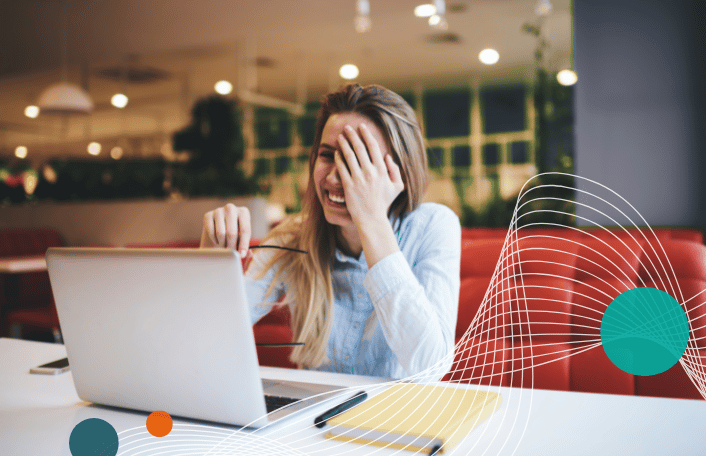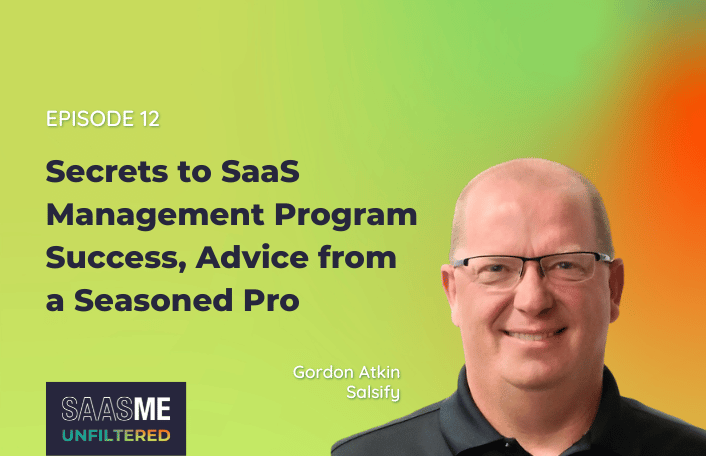
‘Oh Shit’ Moments that Validate the Need for SaaS Management
Table of Contents ToggleOh Shit! I’m Wasting MoneyOh Shit! We Have...
Back
Back
Search for Keywords...
Blog

10/05/2023
Table of Contents
Rome wasn’t built in a day – and neither is your SaaS management program. Yet it can often feel intimidating to get started, especially for smaller teams. Did this deter the IT team at Juni from getting started? Not a chance! They accepted the challenge, confident in the results it could garner for the business. In this episode, Gibson Schnurr, TechOps Lead, shares an inside look at Juni’s path to SaaS management and how they’re tackling SaaS head-on and ramping up their program.
Listen to the full episode on Spotify and Apple Podcasts.
Starting a SaaS management program at a small company can feel incredibly daunting. But Gibson Schnurr and the IT team at Juni didn’t let the scale of the problem deter them.
“I think a lot of organizations, especially over the last year and a half, are focused on cost reduction,” said Schnurr. “That was a big reason why we started moving into a more automated SaaS management flow.”
From laying the groundwork for SaaS management early on to reducing their applications from 500 to 100 company-wide, Schnurr gives the inside scoop at how they got started.
Now that Juni has a SaaS management platform, Schnurr shares how he uses the time saved to refocus on IT strategy.
As he puts it, “It’s more about acting on the data, acting on the problems, the gaps, the pain points instead of finding them.” So get ready to take some strategic action and learn how your team can get on-board with its own SaaS management program.
Name: Gibson Schnurr
What he does: TechOps Lead at Juni
Connect with Gibson online: LinkedIn
“I would say one of the hardest things about [SaaS management] was making sure that we presented the value correctly to the organization. I know right now, currently, our Zylo user base is quite limited to my team and then some of the leadership within our organization. And with that small visibility, it makes it a little bit difficult at our organization to make sure that we show the value. But then when you take into account the amount of FTEs saved by not having to reach out to random people like, ‘Hey, I see this Slack message that you bought this tool. Why? How are you spending it?’ I can just see who spent it on what credit card, accounts payable, easily decide how to take action on it from there. So, from a 30,000-foot view, it all comes down to easing the load on us to make actual decisions about the tech stack and not determining what that tech stack is.”
“Quite early in the company’s journey, a couple years in. We had just started your traditional IT team within the organization. So it was a new thing for the organization to have somebody directly managing this outside of the engineering department. And then another is I don’t believe I’ve had such top-down buy-in within a team like this before. We presented a very large decision to the founders about a direction we wanted to make that would have quite a substantial monetary impact and in the short term maybe would cost us more. And in the end, our CEO just said, ‘You guys are the experts. We’ll trust you.’ I think that’s been what’s so easy. And then we are not also just saying, like, ‘Here, use this tool.’ I think the philosophy that we are explaining as we’re switching the tooling is quite important as well. It gives a lot of context to the end users. So yeah, I would say it’s mostly the buy-in and then just being able to take the time with the end users and explain why we’re rationalizing, even if they’re not always happy about it.
“When I started at Juni, I came with this idea that we needed some form of solution. I wasn’t very aware of the solution industry around this problem. So I came in with the idea that I needed to develop something to handle and automate this for us. And as I started to take on that beast, I was like, ” All right, this isn’t necessarily my competency. It’s not a great use of my time.” So I went into the marketplace and found products beyond any capabilities that I thought that there was. But before that, it was all manual. So we were using products akin to Excel spreadsheets to manage. Relational databases, that’s completely manually updated and I think it takes a substantial amount of manpower, not only to first aggregate that list, but then by the time that that list is aggregated, it’s already out of date and it can be out of date in terms of not only the tools that you’re using, but let’s say the data classification within those tools, making sure that the scope of that data that should be contained there doesn’t creep.”
“I would say it’s just the biggest thing is, before, I worked in managing those tools in terms of determining what those tools are, who’s using them, how much they cost and what they’re used for, and then very little time in taking strategic decisions on how we should act on those tools in the scope of the entire organization, which I think is what my role is more hired for in both cases. It’s more about acting on the data, acting on the problems, the gaps, the pain points instead of finding them. And I think Zylo takes a really large chunk out of that, or a SaaS management tool… And I think the beauty of Zylo is on a Monday morning, open it up and I can see new spend right away. I can see what’s our trend for this year in terms of budget and allocate that to a different tool request that we’re getting, within 10 to 15 minutes. And these are things that we would spend months aggregating, going through different spreadsheets… Information that was typically disparate, hard to aggregate and view is now in one place and I can action on it then.”
“My own experience in knowing that I didn’t want to work in this way of, ‘Oh, we’ll become strategic, we’ll become strategic, we’ll become strategic.’ When the discovery work was done, which products like this exist because the discovery work’s never done, there’s always new spend. No matter how many controls you put in place, somebody’s going to go out and buy a productivity tool, which is a small drop in the bucket, but when everybody can do it, that bucket fills up real quick. But in terms of Juni specifically, just looking at what have we authenticated with Google, seeing this massive list and how many times people have logged in and where, and then seeing the regulated environment that we were moving into and really seeing this as a non- starter, we can’t have this type of data sprawl, uncontrolled data sprawl. So that was a bit of our oh shit moment. I think we were early enough and security and safety was so ingrained in the organization, there was nothing scary, but it’s just like, let’s just keep it safe that way.”
“You save so much money in terms of having a tool like this, and I think we’ve talked about this before, but my philosophy here is it’s very akin to other emerging roles within existing industries, such as supply chain management, which is what my degree is in. They typically just had somebody who didn’t have a specific training in terms of process optimization, logistics, cost savings through materials, processes, et cetera. And as the studies have gone on and shown that if you really harness optimization and increases in performance in those areas, you can cut dollars from your spend to increase your profit instead of having to spend more dollars to increase your profit through revenue. And I think it’s the same with SaaS management. The more ability that you have to optimize, make your solutions scalable, you’re better to cut off some of your costs to increase your profit, and it’s cheaper than increasing your profits through increasing your revenue. The cost for customer acquisition can be quite high versus the cost of optimizing your tech stack can be quite low, and I think that’s where you can really impact your bottom line.”
“Initially when we started our look for these SaaS management tooling, a lot of organizations’ biggest sells was having somebody step in and do this process for you. So a lot of competitors in your space, that’s the first thing they talk about. Both me and my manager were thinking, ‘Why do we need to outsource this? We can get that savings.’ When we flipped that on its head and said, ‘Okay, if we know we can get these savings, as people who’ve been in this industry a while, who’ve negotiated with a lot of these vendors in the past at other organizations, then we know that once you have an understanding of that, it becomes easier to let go of that control and let somebody else with that same understanding.’… And then I can just completely fire and forget, let that go, and then I can focus on things that are more specific to us in terms of regulation, compliance and risk management.”
13:11 – “It’s more about acting on the data, acting on the problems, the gaps, the pain points instead of finding them. ”
16:35 – “Products like this exist because the discovery work’s never done, there’s always new spend.”
19:09 – “I think [SaaS management is] where you can really impact your bottom line.”
Listen and Subscribe to SaaSMe Unfiltered wherever you listen to podcasts.
ABOUT THE AUTHOR

Cory Wheeler
As Zylo’s Chief Customer Officer, Cory is responsible for helping our customers drive ROI and SaaS Management success with Zylo. He helps companies of all sizes effectively discover, optimize, and govern their SaaS through Zylo’s platform and services. Prior to founding Zylo, Cory spent 15 years in finance and procurement, managing categories and sourcing teams at Arthur Andersen, BearingPoint, and both Takeda and Astellas Pharmaceuticals. He built the procurement organization at ExactTarget, and managed the integration with the Salesforce Marketing Cloud procurement organization in 2015. He and his family reside in Indianapolis, IN, where they can be found cheering for the Purdue Boilermakers and Chicago Cubs.

Table of Contents ToggleOh Shit! I’m Wasting MoneyOh Shit! We Have...

Table of Contents ToggleEpisode SummaryGuest SpotlightEpisode HighlightsUncovering the Impact of SaaS...

Table of Contents ToggleEpisode SummaryGuest SpotlightEpisode HighlightsEmbrace Flexibility in Your Governance...

Table of Contents ToggleEpisode SummaryGuest SpotlightEpisode HighlightsFor a CIO, Taking a...
| Cookie | Duration | Description |
|---|---|---|
| cookielawinfo-checkbox-analytics | 11 months | This cookie is set by GDPR Cookie Consent plugin. The cookie is used to store the user consent for the cookies in the category "Analytics". |
| cookielawinfo-checkbox-functional | 11 months | The cookie is set by GDPR cookie consent to record the user consent for the cookies in the category "Functional". |
| cookielawinfo-checkbox-necessary | 11 months | This cookie is set by GDPR Cookie Consent plugin. The cookies is used to store the user consent for the cookies in the category "Necessary". |
| cookielawinfo-checkbox-others | 11 months | This cookie is set by GDPR Cookie Consent plugin. The cookie is used to store the user consent for the cookies in the category "Other. |
| cookielawinfo-checkbox-performance | 11 months | This cookie is set by GDPR Cookie Consent plugin. The cookie is used to store the user consent for the cookies in the category "Performance". |
| viewed_cookie_policy | 11 months | The cookie is set by the GDPR Cookie Consent plugin and is used to store whether or not user has consented to the use of cookies. It does not store any personal data. |
